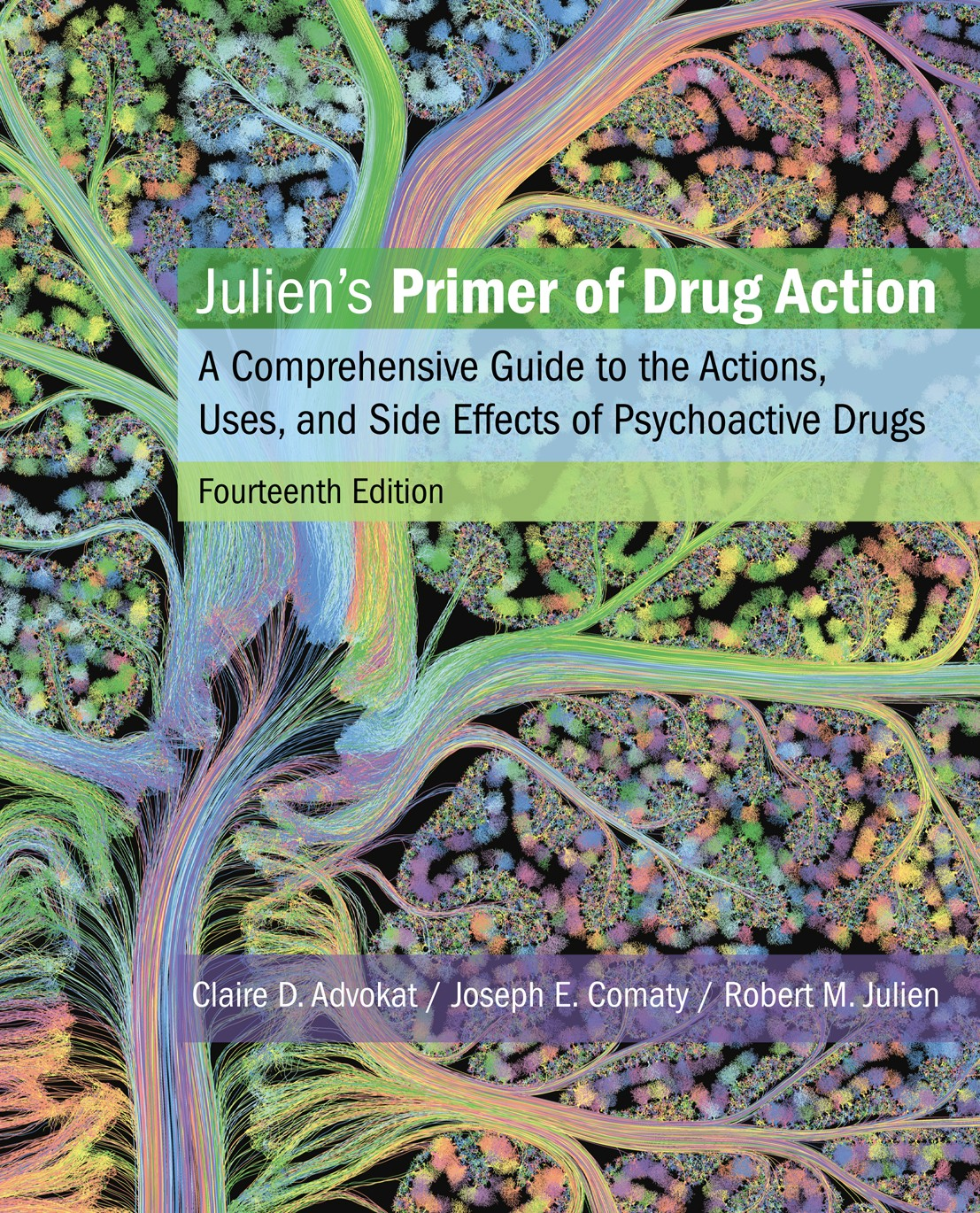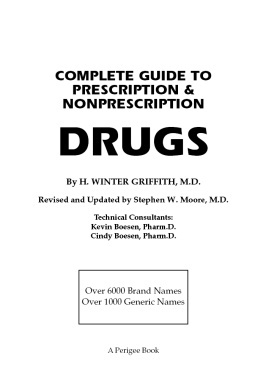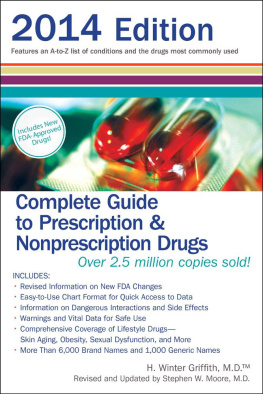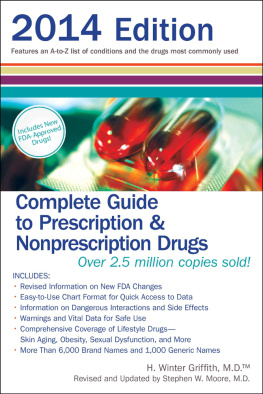
Juliens
Primer of Drug Action
Juliens
Primer of Drug Action
A Comprehensive Guide to the Actions, Uses, and Side Effects of Psychoactive Drugs
Fourteenth Edition
- Claire D. Advokat, Ph.D.
- Louisiana State University
- Joseph E. Comaty, Ph.D., M.P.
- Baton Rouge, Louisiana
- Robert M. Julien, M.D., Ph.D.
- Portland, Oregon

Vice President, Social Science and High School: Charles Linsmeier
Director of Content and Assessment, Social Sciences: Shani Fisher
Senior Associate Editor: Sarah Berger
Assistant Editor: Melissa Rostek
Marketing Manager: Clay Bolton
Marketing Assistant: Chelsea Simens
Director of Media Editorial: Noel Hohnstine
Associate Media Editor: Nik Toner
Media Project Manager: Joe Tomasso
Director, Content Management Enhancement: Tracey Kuehn
Senior Managing Editor: Lisa Kinne
Senior Project Manager: Matt Gervais, Lumina Datamatics, Inc.
Senior Project Manager: Andrea Stefanowicz, Lumina Datamatics, Inc.
Senior Workflow Project Manager: Paul Rohloff
Permissions Manager: Jennifer MacMillan
Director of Design, Content Management: Diana Blume
Senior Design Manager: Blake Logan
Art Manager: Matthew McAdams
Composition: Lumina Datamatics, Inc.
Cover Photo: Greg Dunn
Library of Congress Control Number: 2018938114
ISBN: 978-1-319-20054-1 (epub)
Copyright 2019, 2014, 2011, 2008 Worth Publishers
All rights reserved
Worth Publishers
One New York Plaza
Suite 4500
New York, NY 10004-1562
www.macmillanlearning.com
ABOUT THE AUTHORS
Claire Advokat received her Ph.D. in physiological psychology from Rutgers University, following which she completed an NIH Postdoctoral Fellowship at the College of Physicians and Surgeons of Columbia University in New York City. She then served on the faculty of the Department of Pharmacology at the University of Illinois Health Sciences Center in Chicago. In 1989, she joined the Department of Psychology at Louisiana State University, retiring in 2012 as an emerita professor. Her area of expertise is the neurobiology of psychoactive drugs, including substances of abuse as well as medications developed for the treatment of mental disorders.
Joseph E. Comaty received his M.S. in experimental psychology from Villanova University, his Ph.D. in psychology with a specialization in clinical neuropsychology from the Rosalind Franklin University of Medicine and Science in Illinois, and his postdoctoral Masters Degree in clinical psychopharmacology from Alliant University/CSPP in California. He retired from his position as chief psychologist, HIPAA privacy officer, and director of the Division of Quality Management of the Louisiana State Office of Behavioral Health, Louisiana Department of Health, in Baton Rouge. He currently serves as a consultant to that agency, conducts forensic fitness for duty evaluations, and has also held an adjunct faculty appointment in the Department of Psychology, Louisiana State University. Dr. Comaty is a clinical and medical psychologist, licensed to prescribe psychotherapeutic drugs in the state of Louisiana.
Robert M. Julien, M.D., received his M.S. and Ph.D. in pharmacology from the University of Washington and his medical degree from the University of California at Irvine. His many research articles focus on the psychopharmacology of sedative and antiepileptic drugs. Formerly an associate professor of pharmacology and anesthesiology at the Oregon Health Sciences University, Dr. Julien retired as staff anesthesiologist at St. Vincent Hospital and Medical Center in Portland, Oregon. For over three decades, Dr. Julien single-handedly accomplished the herculean task of revising each edition and maintaining a succinct yet comprehensive and clear review of the most up-to-date advances in psychopharmacology. He is also an active consultant and lecturer on pharmacology and anesthesiology.
CONTENTS
PREFACE
The fourteenth edition of Juliens Primer of Drug Action marks over 40 years of continuous publication of this now classic textbook, which has as its goal the documentation of current understanding and advances in the psychopharmacological treatment of mental illness and substance abuse.
Historical discoveries that certain chemical compounds could help people who suffer from psychosis, depression, anxiety, mania, and other neurological and psychological conditions led to the development of medications that greatly improved the treatment of these devastating disorders. And similarly, during this time, there has been a corresponding explosion in our knowledge of the neurological substrates, the receptors, and enzymes that are affected by these drugs (discussed in ), and an appreciation that they can be most effective when integrated with appropriate behavioral therapy. Unfortunately, progress in the basic science of psychopharmacology has not yet produced corresponding clinical improvements.
As with each of the prior editions, we strive in the fourteenth edition to present the information in a clear, concise, and timely manner, describing the general principles of each class of psychoactive drugs, as well as providing specific information about the individual agents. Each chapter includes an overview of the current models of the disorders, background and mechanisms of action of the drugs, and rationales for drug treatment. Chapters on drugs of abuse provide historical context and epidemiological updates, discussions of the classic agents, and descriptions of the most recent drugs of concern, as well as the latest developments in regard to pharmacological treatments of these disorders.
As in earlier editions, each chapter of the fourteenth edition has been revised to reflect the latest developments in the field. A broad overview of these changes since the last edition suggests the following prominent themes.
First, there has been continued expansion of the clinical indications for the major therapeutic drug classes. These ongoing changes reflect efforts on the part of the pharmaceutical companies to expand the use of their products to a broader array of behavioral health conditions.
Second, the rate of drug development for the treatment of behavioral health disorders has slowed. Although a few new agents have been brought to market since the last edition of this book, most of these agents are so-called me too drugs that are similar to those already on the market. In addition, the newer medications, referred to as second generation or even third generation, have not been shown to produce better outcomes compared to what are referred to as first generation drugs originally marketed in the mid to late 1950s. The differences among these drugs are more a reflection of differing side effect profiles. This understanding has revived interest in the original agents and in comparisons of therapeutic effectiveness, not only among psychiatric medications, but also between pharmacological and nonpharmacological treatments. Accordingly, the discussion of antipsychotic drugs () has been completely revised and updated to reflect current concepts of psychopharmacological mechanisms of action.
Third, one practical effect of this pessimistic view is a decrease in current pharmaceutical investment into research and development of new psychotropic medicationsbut with two exceptions. The first is the ongoing research, so far unsuccessful, for treatments of Alzheimers disease ().
Next page








